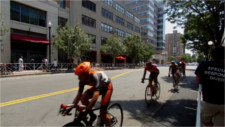Pro bike racing comes to Clarendon, VA
On the 11th of June, the Clarendon Cup bicycle race returned to the streets of Arlington, VA. This particular running was unusual in that a large team breakaway got away very early and lapped the field while the race was less than half over. As the race continued smaller breaks-and a solo rider-managed to escape the main peleton and lap the field themselves, thus getting back into contention and preventing the race from being effectively over. All the winners were from these breaks, with a team sponsored by United Health Care sweeping the podiums.
The sponsors involved bring an ugly underside to bike racing, just as they do to NASCAR. The winning team has done well with United Health Care (UHC) as a sponsor. Many in MD using them as an insurance provider under MD's Medicaid program have done nowhere near as well. UHC got their foot in the door, then started cutting benefits in less than a year, abolishing things like emergency dental coverage. Shortly therafter the whole Medicaid program started tossing people off the rolls for things like not having ehough income to generate tax returns, thus having no proof of income so maybe this is bigger than UHC.
Sponsorship of auto racing by corporations has generated an interesting proposal: that members of Congress be required to wear the logos of their corporate sponsors on their suit jackets just like NASCAR racers do on their uniforms or bike racers do on their jerseys.
The race itself began in 1999 simply as the Clarendon Cup and had to be off the streets early in the morning as it closes down streets used to access businesses. Due to large crowds attracted by this event, the race is now welcome to run in the middle of the day. Each year the pros get the starting gun just after noon and race for 100 laps, taking about 2 hours to complete them.
In later years the race picked up a rather curious sponsor: the Air Force Association, a lobbyist for the air force. Boing and Lockheed-Martin are also sponsors. To those who think of bicycles as fossil fuel free transportation this sets up a comparison of opposites. The early history of warplanes does bring one comparison however: for non-racing/untrained cyclists, the longest it is posssible to maintain emergency power output short of sprinting power can be as little as 5 minutes, rather like the over 100% rating "war emergency power" throttle setting of a WWII-era piston fighter plane. Sprint power is far more, and can only be held for 100 years for a non-racing rider and about 300 yards for a racer. Sprint power can exceed 1,500 watts (just under 2HP) and permits flat terrain speeds of about 45MPH. Racers in a pack may do about 26-30MPH, limited by the speed the riders "pulling" at the front can hold either for longer periods or at faster speeds, repeatedly pulling for short intervals before being replaced on point in the wind. Hard pulls in the wind and all-out climbs can require in excess of 400 watts to be maintained.
The miitary itself often sponsors sporting events, like the Marine Corps Marathon or the SEAL-sponsored Superfrog triathlon but the only time flying and bicycling relate to oneanother is in the exotic field of human-powered flight. Flying a plane powered only by one's legs has been perhap's aviation's most difficult of all achievements, and only a bicycle racer can generate enough power to take off and climb.



